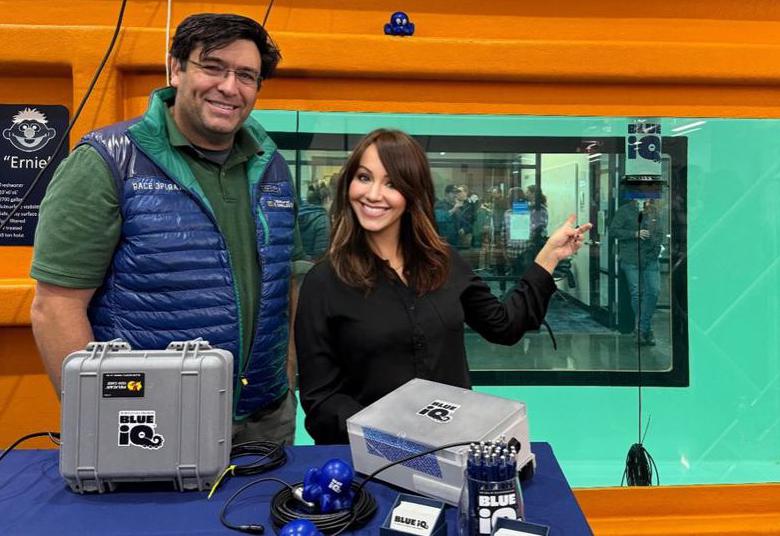
PROVIDENCE — CEO Kim Gavin’s company, BLUEiQ, specializes in what’s called underwater sensing, using sound to study marine life, map the sea floor, or identify underwater objects or vehicles.
Gavin remembers an “aha’’ moment when she and BLUEiQ cofounder Robert McGurrin attended a conference in Virginia in 2022. There, they watched a 2016 documentary called “Sonic Sea,’’ which chronicled the effect of underwater noise on marine life.
“We both looked at each other and said, ‘Wow, we’ve done a lot of applications that listen with sound, but we’ve never thought about applying sound for detection, for sensing biodiversity and … [for] marine conservation,’’’ said Gavin, who has worked on different sensing applications for the defense and intelligence industries. “So that was our aha moment. We founded BLUEiQ that next year.’’
The company has offices in Newport, R.I., Boston, and Gulfport, Miss. We spoke to Gavin for this story.
Q. What are you trying to do with BLUEiQ?
A. Sound is one of the most efficient ways to detect objects. We use passive acoustic sensing to detect objects underwater, whether it’s marine mammals, man-made threats, or nefarious drones endangering ports and harbors … [We’re] listening to coral reefs, listening to oyster reefs. There’s a number of different applications for the use of just passively listening to sound.
And you can actually track health and habitats of a variety of different marine mammals using sound. And that’s what we do as a company. We develop hardware, we develop software, and we have custom solutions using underwater sound detection.
Q. How do you go about doing this?
A. We use machine learning, artificial intelligence, and we create detectors to interpret what we’re listening to. It’s not as simple as just putting a recorder underwater and knowing exactly what you’re listening to. There’s a variety of different frequencies to listen to underwater. And really, we view sound as another medium for helping map and understand our oceans.
Q. What does BLUEiQ offer?
A. We’ve designed our product, OpenEar, to be an open platform for scientists or marine operators to develop their own custom applications, or we can actually help them develop it.
We have a capability that can be deployed on its own … We also have embedded it as what we call a payload on different vehicles, whether they be underwater … or surface vehicles or buoys or drifters, or we can also just provide custom solutions.
Q. How does it work?
A. We provide capability for real time alerting.
So, an example of that would be in the case of North Atlantic right whales … we provide an alert in advance of detecting that object of interest in the water. So, we can help prevent [vessels] from hitting and harming whales in the water.
We can provide alerting capabilities for ports and harbors, for security purposes, for listening to different types of vessel detections underwater.
We envision that the idea of being persistent, ubiquitous, autonomous is really the future of underwater sensing. I like to tell people that it’s really similar in our minds to overhead sensing 20 years ago. A lot of … satellite imagery in space has really evolved over time to be very persistent and ubiquitous. And we see the same for underwater sound for our oceans. It will become just another medium for mapping.
Q. What other products are you developing?
A. With [Maine-based Seaport Systems], we just launched one product, which is our OpenEar AI Drifter. So, it is similar to a buoy. It drifts and can collect underwater sound data and transmit that data. We’re also working with them on other products … Next year we’ll be coming out with some new ones.
Q. What’s your target market?
A. Right now we’re very open to working with a variety of different customers, so everyone from marine science and research institutes, aquariums … scientists who are bioacousticians who know and understand underwater sound and are using that for marine mammal protection.
Another very big marketplace … for us is port and harbor security. We’re really looking at understanding behaviors of vessel detections, other kinds of nefarious drone activity happening in and around ports, and providing data that can help [the] Coast Guard, Department of Homeland Security, and the ports understand their common operational picture, what’s happening in and around their port [using sound].
Less than 1 percent of the world’s oceans are persistently monitored using sound, underwater sound. And we see an opportunity — over 70 percent of the Earth’s surface is covered by [the] ocean. So, only a tiny fraction of that is being detected using sound today.
And then defense is another big customer of ours. [Defense Advanced Research Projects Agency] has been a very strong customer of ours, which is an agency that focuses mainly on innovation and in research and development. Office of Naval Research and other components of defense and Navy. And then offshore wind.
Omar Mohammed can be reached at omar.mohammed@globe.com. Follow him on Twitter (X) @shurufu.

